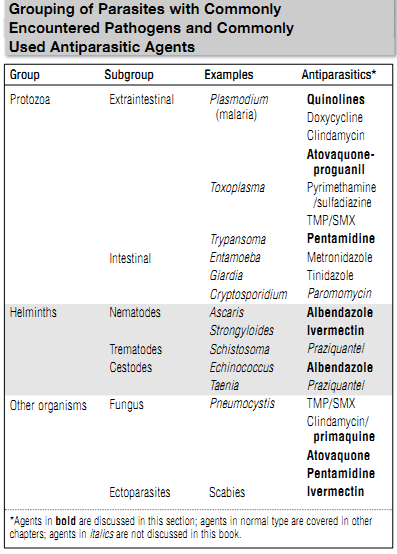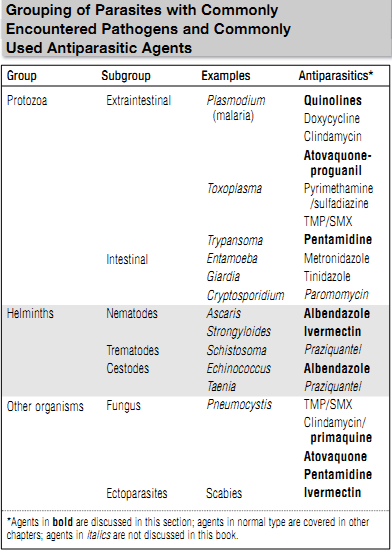


 النبات
النبات
 الحيوان
الحيوان
 الأحياء المجهرية
الأحياء المجهرية
 علم الأمراض
علم الأمراض
 التقانة الإحيائية
التقانة الإحيائية
 التقنية الحيوية المكروبية
التقنية الحيوية المكروبية
 التقنية الحياتية النانوية
التقنية الحياتية النانوية
 علم الأجنة
علم الأجنة
 الأحياء الجزيئي
الأحياء الجزيئي
 علم وظائف الأعضاء
علم وظائف الأعضاء
 الغدد
الغدد
 المضادات الحيوية
المضادات الحيوية|
Read More
Date: 3-4-2016
Date: 3-4-2016
Date: 3-4-2016
|
Introduction to Antiparasitic Drugs
There is a tremendously unequal variation in the human burden of parasitic disease, based on geography, industrialization/hygiene, and immune status. It is estimated that up to half of the world’s population is chronically infected with parasites. The extent of parasite-related morbidity and mortality depends on parasite burden, preexisting im-munity, and patient comorbidities. We will focus on parasitic diseases primarily affecting inhabitants of industrialized nations. Parasites causing human disease can be broadly grouped into two main categories, the unicellular protozoa and the multicellular helminthes ( Table 1). The protozoa have many subgroups, but we present them as primarily intestinal or primarily extraintestinal pathogens. The helminthes are subdivided into nematodes (round-worms), trematodes (flukes), and cestodes (tape-worms). Examples of common pathogens for each group are given along with some of the agents used in their treatment. Although not technically considered parasites, two other organisms that are susceptible to antiparasitic drugs will also be addressed: Pneumocystis jirovecii (technically a fungus) and Sarcoptes scabei (the scabies mite, technically an Arachnid).
Table 1

Drugs with antiparasitic activity range from everyday antibacterial drugs (metronidazole, doxycycline), to mildly exciting agents seen occasionally in routine practice (chloroquine, pentamidine), to the most exotic agents that can be obtained only from the Centers for Disease Control and Prevention (CDC) in the United States (diethylcarbamezapine, sodium stibogluconate). In this Part we will focus on the middle category, leaving the details of antibacterial drugs to their own chapters and the exotic agents to those with a keen interest.

References
Gallagher ,J.C. and MacDougall ,c. (2012). Antibiotics Simplified. Second Edition. Jones & Bartlett Learning, LLC.



|
|
|
|
دخلت غرفة فنسيت ماذا تريد من داخلها.. خبير يفسر الحالة
|
|
|
|
|
|
|
ثورة طبية.. ابتكار أصغر جهاز لتنظيم ضربات القلب في العالم
|
|
|
|
|
|
|
سماحة السيد الصافي يؤكد ضرورة تعريف المجتمعات بأهمية مبادئ أهل البيت (عليهم السلام) في إيجاد حلول للمشاكل الاجتماعية
|
|
|